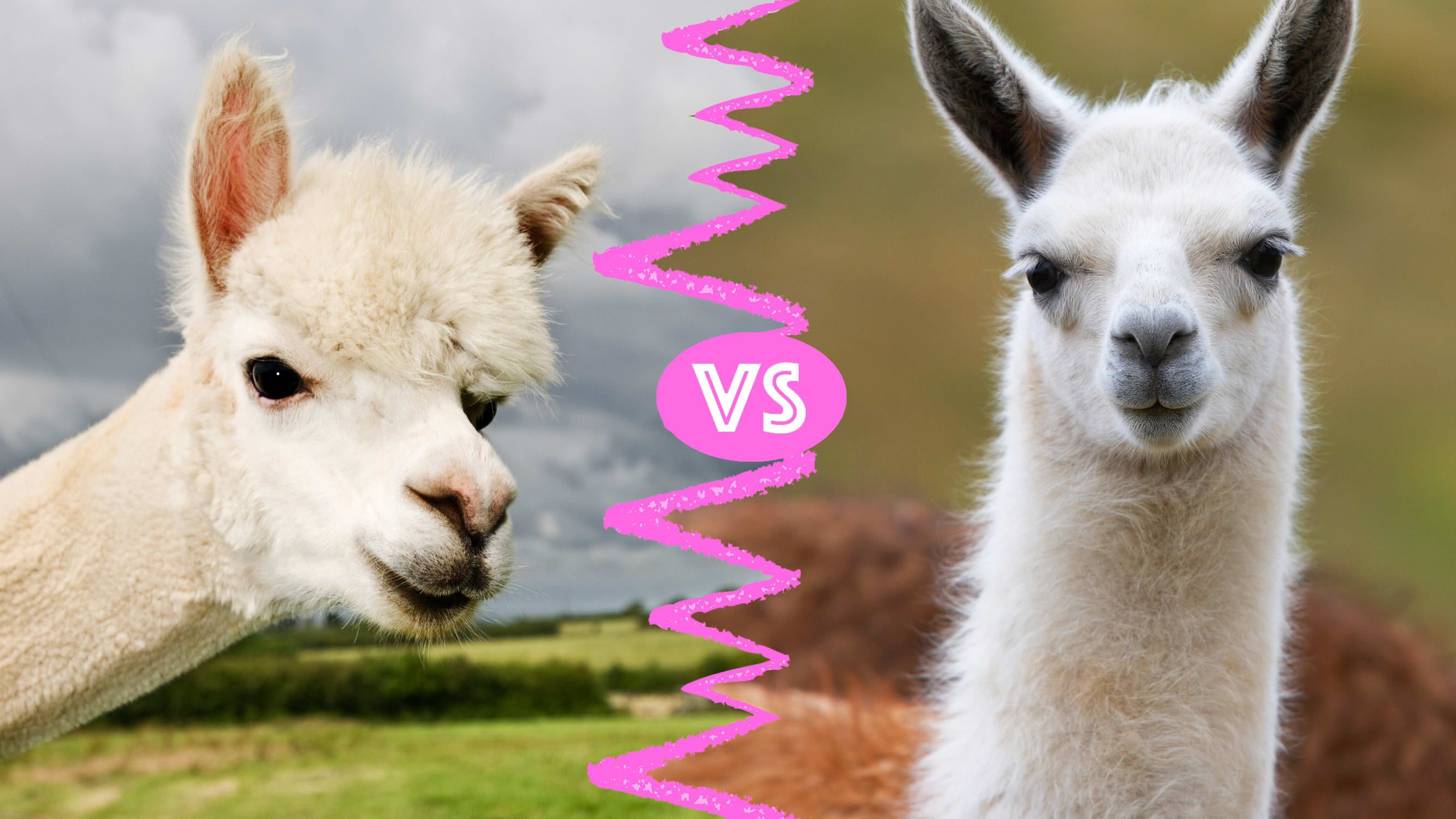Llama vs Alpaca: The 5 Main Differences Explained

In the enchanting realm of South American wildlife, two charming and closely related creatures often steal the spotlight: llama vs alpaca. With their big, expressive eyes and fluffy coats that seem to beckon for a cuddle, it’s no wonder that these camelids have captured the hearts of animal lovers around the globe. But beneath their similar exteriors lies a world of fascinating differences that can leave even seasoned enthusiasts scratching their heads. Are you ready to unravel the mystery behind these captivating cousins?
While both llamas and alpacas are known for their gentle demeanor and unique contributions to textile production, they each possess distinct characteristics that set them apart in both appearance and behavior. From size variations to fleece quality, understanding these key distinctions not only enriches your knowledge but also enhances your appreciation for these remarkable animals. 
Key Points: Llama vs Alpaca
Size and Build: Llamas are generally larger and more robust than alpacas, standing about 4.5 to 6 feet tall at the head compared to the alpaca’s height of around 3 to 4 feet. This size difference leads to varying roles in their respective herds; llamas often serve as pack animals while alpacas are primarily raised for their fiber.
Fleece Characteristics: While both animals produce soft fleece, alpaca wool is typically finer and softer than llama wool. There are two types of alpaca—Huacaya and Suri—each offering distinct textures, from fluffy to silky. This variation has made alpacas particularly sought after in the textile industry.
Temperament: Llamas exhibit a more independent demeanor, making them effective guardians for livestock as they tend to be fearless when it comes to protecting the herd. In contrast, alpacas are naturally more social creatures that thrive on companionship with other animals.
Vocalization Differences: The vocalizations of these two species provide insight into their behavioral traits; llamas often use loud guttural sounds called hum or orgle while communicating with one another, reflecting their guardian nature. Alpacas opt for quieter communication through soft humming, reflecting their more gentle disposition.
Also read a guide about Guard Donkeys: Protective Livestock Ideas.
Main Difference Between Llama And Alpaca:
When comparing llamas and alpacas, one of the most striking differences is their size and purpose. Llamas are typically larger, standing between 5.5 to 6 feet tall at the head and weighing up to 450 pounds, making them well-suited as pack animals. Their robust build allows them to carry heavy loads across mountainous terrains, a trait celebrated in Andean cultures for centuries. On the other hand, alpacas are smaller and more delicate, standing around 3 feet tall at the shoulder and weighing about 150 pounds. Their primary purpose is fiber production; each alpaca produces luxuriously soft fleece that is highly prized in the fashion industry.
Comparing Alpaca Vs Llama: Size
When comparing alpacas and llamas, size is one of the most immediately noticeable distinctions. Alpacas typically stand about 34 to 36 inches tall at the shoulder and weigh between 100 to 175 pounds. Their smaller stature contributes to their gentler demeanor, making them particularly appealing for fiber farming and as companion animals. Llamas, on the other hand, are considerably larger, reaching heights of approximately 42 to 48 inches at the shoulder and often tipping the scales at anywhere from 250 to 400 pounds. This size advantage bestows llamas with a commanding presence, allowing them to perform roles such as pack animals or guardians for livestock.
Llamas Vs Alpacas: Faces
When you take a closer look at llamas and alpacas, their faces reveal a remarkable difference in character and expression. Llamas often sport long, elegant faces with pronounced cheekbones that evoke a sense of regality and confidence. Their eyes are strikingly expressive, framed by bushy eyelashes that lend them an almost cartoonish charm. This unique facial structure not only accentuates their stature but also gives llamas an air of aloofness as if they effortlessly command attention.
Alpacas possess rounder faces adorned with softer features that radiate a childlike innocence. Their wide-set eyes exude warmth and curiosity, inviting interaction as they approach with gentle inquisitiveness. The distinctly shorter snouts add to their adorable appeal, making them particularly captivating to visitors at farms or petting zoos.
Llamas Vs Alpacas: Hairs
llamas and alpacas present a fascinating study in contrasts. Llama hair is coarse and slightly wiry, making it ideal for durable purposes like rope-making or outerwear that endures harsh conditions. In contrast, alpaca fleece is renowned for its softness and luxurious feel, often likened to cashmere. The natural sheen of alpaca fiber not only adds a visually appealing dimension but also serves to highlight the various colors available ranging from pure white to deep browns and even rare shades like lavender.
Alpaca Vs Llama: Purpose And History
Alpacas and llamas, while often confused, serve distinct purposes rooted in their unique histories. Alpacas, domesticated primarily for their luxurious fiber, were developed around 6,000 years ago by the Inca civilization in the high Andes of South America. Their fleece is prized for its softness and warmth, making them a key resource in traditional Andean textiles.
llamas were bred primarily as pack animals due to their strength and endurance. They have historically played a pivotal role in Andean culture by transporting goods across challenging mountainous terrain. With a stronger build than alpacas and a more assertive personality, llamas also assume guard duties for herds against predators.
Llama Vs Alpaca: Behavior and Lifespan
llamas and alpacas showcase distinct personalities that reflect their differing roles in human society. Llamas, bred primarily as pack animals, exhibit a more assertive and independent demeanor. They are often more curious and protective of their territory, which can lead them to be quite vocal when they sense intrusions or threats. In contrast, alpacas are inherently social creatures that thrive in herds and display a gentler disposition. Their subtle communication through body language and soft humming creates a serene atmosphere among them; you might find an alpaca nuzzling against its companion to show affection or comfort.
In terms of lifespan, both llamas and alpacas enjoy relatively lengthy lives compared to many other domesticated animals typically 15 to 25 years depending on care and environment. Yet the longevity of these two species plays into their unique behavioral traits: llamas’ robust nature allows them greater resilience under challenging conditions, while the delicate behaviors of alpacas remind us of the importance of companionship for wellbeing. Both animals can inspire deeper reflections on how companionship and individuality shape our own experiences through life’s journey.
Conclusion
While llama vs alpaca may appear similar at first glance, their distinct characteristics set them apart in significant ways. Llamas are larger and more independent, often serving as pack animals, whereas alpacas are smaller and primarily bred for their luxurious fleece. Understanding these differences can help enthusiasts choose the right animal for their needs, whether it’s for companionship, fiber production, or even farming purposes. As interest in these fascinating animals continues to grow, it is essential to appreciate their unique traits and contributions to our lives. So whether you’re considering adopting one or simply looking to learn more about them, dive deeper into the wonderful world of llamas and alpacas today!





